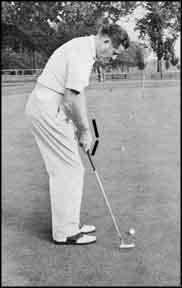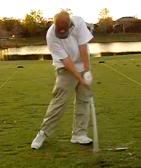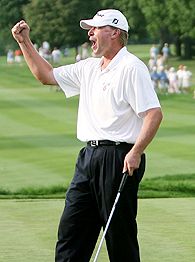I’ve been asked the question ‘why would anybody want to hit a muscleback blade iron over a cavity back?’ quite often. And recently I’ve seen this question posted on other forums as well.
Unfortunately, what we are seeing is less and less OEM’s making muscleback blades. Cleveland Golf makes a muscleback blade set with their new CGTour line, but it does not offer a muscleback option with the 3, 4 and 5-irons. Ping has never offered a true, muscleback blade (to my knowledge) and newer OEM’s like Tour Edge, Boccieri, Fourteen Golf, etc. do not offer a true muscleback blade option either.
I discussed this with Bobby Siravo (www.ifitgolf.com) at the PGA Merchandise Show. The reason for the decline in muscleback blade production is that they simply do not sell well. But I believe that they do not sell well because the marketing and advertising of the products is piss poor.
First though, let’s go over the very basic difference between Muscleback and Cavity Back
CAVITY BACK AND MUSCLEBACK

The Ping Eye 2 is a ‘cavity back’ and the Hogan Apex Redline is a classic ‘muscleback’ iron. As you can see, the back part of the clubhead is different as the Ping Eye 2 has the back part ‘taken out’ (aka cavity) whereas the Hogan iron has the back of the club ‘in tact.’
The main idea is that with the cavity back, the mass behind the sweetspot is taken out so the toe and the heel will have more mass and thus making the club more forgiving. This would also get the Center of Gravity of the club lower on the face, so the golfer can more easily hit the ball higher in the air.
With the muscleback blade, the most amount of mass is right behind the clubhead.
THE STORY OF CAVITY BACKFrom my experience, cavity back didn’t start to become big until the Ping Eye 2 came out in the early 1980’s. And then the popularity really increased when the Tommy Armou 845s came out in 1988.

The 845s were popular because the Ping Eye 2’s looked almost like a plastic children’s club whereas the 845’s, which still had a lot of offset (although progressive offset), looked more normal. And to help matters, they wound up signing popular golf Fred Couples to a large endorsement deal.
Back then, all cavity backs had a lot of offset and were cast irons, made from stainless steel. So the judgement from the general public back then was still that cavity backs, which had that large amount of offset, were still meant more towards the hacker because that offset would help the golfer get the club up in the air. That being said, there were more and more PGA Tour players using the Ping Eye 2 and Tommy Armour 845s.
One of the other concepts was the differences in feel. Back then, forged felt much softer than cast because the cast clubs were made from a much harder steel, usually something like 17-4 stainless steel. Whereas forged would be made from much softer steel like 1020, 1025 or 1030 carbon steel.
And back then, there were NO forged cavity backs. That didn’t happen until, ironically, Hogan came out with the forged Hogan Edge cavity back irons.
So back in the 80’s, musclebacks were the clubs of choice for more of the single digit handicappers and better because the perception of cavity backs were that they were more meant for the hacker and at that time they didn’t feel as good because the steel was harder.
HOGAN AND TITLEIST
What’s ironic about Hogan Company is that they were pretty much THE muscleback iron maker for roughly 3 decades. They were then the first company to come out with the forged cavity back which was well ahead of its time, but seemed to have led to their demise as well. Once the forged cavity back was made, then cavity backs no longer had that disadvantage of not feeling as good as the muscleback blade.
Then the Titleist 962 irons came along.

What many people who got into the game in the last ten years do not realize is that it was not all that long ago that Titleist was more or less known for their golf balls and golf gloves. They did make equipment, but for the most part it was not all that popular outside of the Tour Model muscleback irons which had lukewarm popularity. Probably the piece of equipment that was most popular for Acushnet was the Bullseye putter

Titleist actually made some regular DCI cavity back irons which had more popularity with the higher handicap players. But once the 962 was born, their iron sales took off. They then made a really nice looking titanium driver that looked more like a classic driver than the other titanium drivers. Then they added Foot-Joy, Scotty Cameron and Vokey and they are the company that you see today. But back in 1988, they were just the main golf ball company and that’s it.
Once those 962’s came along (particularly the smaller version 962B irons), we started to see cavity backs that followed that design of a smaller offset and a more classic design. Thus, between the Hogan Edge’s and the 962’s, now we had cavity backs that could offer a classic design or a forged feel. And eventually that led into today’s ‘player cavity backs’ which have a forged feel and more of a classic design.
CURRENT DAY MUSCLE BACKAs cavity back progressed, muscleback made changes as well. The muscleback irons of the 60’s and 70’s have very long hosels. In fact, my 1963 Hogan IPT’s have a 3” hosel. This hosel would also move the sweetspot up higher on the clubface and more towards the heel. Many people who have seen the personal clubs that Ben Hogan used have often remarked how there’s a spot on the club where the club is worn down, but it’s towards the heel of the club. Some people have made the erroneous claim that Hogan hit ‘heel cuts.’ But the reality is that he hit it flush, time after time, because the sweetspot of those irons was towards the heel. As an owner of four different sets of irons that have the long necks, I can assure you that the sweetspot is much more towards the heel.
Because of that higher CoG on the clubhead, they made the lofts weaker because the ball would launch too low with today’s modern lofts. But eventually the cavity backs were designed so the CoG was so low that the OEM’s then strengthened the lofts. This helped the ball travel further and eventually OEM’s started doing similar things with the muscleback blades.
What happened with today’s muscleback blades is they shortened the hosel and got the sweetspot more in the center of the clubhead and down lower on the face. This not only helped golfers get the ball up in the air easier, but it also made the current day blades more forgiving. Back in the 80’s, the worst thing you could do was mis-hit a muscleback blade on the toe of the club. Now the golfer can mis-hit the ball on the toe or the heel and still hit a reasonably decent shot.
This changing in the CoG’s also made forced OEM’s to lower the lofts of the clubs so they wouldn’t go too high. For instance, the ’88 Apex Redlines had a PW loft of 50*. Most of today’s PW’s with muscleback blades have a loft of 47 or 48*. What’s even crazier is that many of today’s cavity back irons have PW lofts of 45* and some go as strong as 43*!
SO WHY MUSCLEBACK?That question still remains. Hopefully my answers will help the reader better understand why somebody may want to go to muscleback irons.
The common thing I hear about musclebacks is that ‘they are easier to work the ball with.’ I used to believe that as well, but I’m not so sure that’s really true. But this is much like the D-Plane talk when you hear PGA Tour pro Joe Schmoe tell the audience how they work the ball based off the ‘old’ ball flight laws, which are incorrect. The fact is that very few PGA Tour pros truly work the ball these days. For starters, most of them hit it almost dead straight. A ‘fade player’ or a ‘draw player’ on the PGA Tour will look almost dead straight to the average amateur when watching them in person.
And the PGA Tour players who do have a noticeable bend in their shots usually will never try to work the ball even if the hole calls for it. So if Rocco Mediate, who hits a sizeable draw, gets on a hole where it’s a pretty sharp dogleg right…he’s not going to try and hit a fade. He’s still going to hit his big draw. It’s much like the power, pull hitter in baseball who has the opposite side of the field wide open as the defense makes their shift. They will still try to pull the ball because that’s what they do best. And Rocco will try and hit the draw because that’s what he does best.
So the ‘working the ball’ talk is usually overblown. And I think it’s harder to work the ball these days anyway because the ball just seems to fly straighter these days.
THREE FUNDAMENTALS OF THE GOLF SWINGI believe that there are three fundamentals of the golf swing.
-Controlling the Clubface
-Controlling the Clubhead Path
-Controlling the Low Point
Let’s take a look at a pic I have of a CB Titleist 962 and a MB Bridgestone J33.

As you can see, the Bridgestone has a smaller head and a thinner sole. And because the Titleist is a cavity back, it has ‘perimeter weighting.’
I believe that hitting the golf ball is a *skill.* And when you don’t test your skills regularly, they start to erode until you sharpen them up again.
The clubface can be responsible for a lot of things that happen with a golf shot. A major one of them being sweetspot contact. Close your clubface and now you’re more likely to hit the ball off the toe of the club. But with perimeter weighting, you are more likely to get away with that toe hit and even WORSE, not feel it so bad.
Again, that’s a BAD thing for those looking to improve their golf swing because you cannot learn if you don’t feedback. When you don’t get feedback, you’ll just keep doing the wrong things.
Same with clubhead path. Particularly if you have a very inside-to-out clubhead path which is often caused when the golfer gets the handle too high at impact. That high handle means that the golfer has the club at a higher lie angle than the club was designed to have, thus they hit it off the toe.
But you will not feel that as badly if you have perimeter weighting.
The sole of the Titleist 962 is much thicker. This is done so if the golfer catches it a little fat, they can still get the clubhead thru the ball. Also, with the Center of Gravity of the Titleist being lower, the ball gets up in the air easier. So a golfer can hit it thin and still get it up in the air well.
However, this does not test the precision of the golfer’s low point. So over time the golfer is more likely to keep hitting it fat and/or thin because their low point control has eroded.
Then the cavity backs are often designed to make them go further with their low CoG and super strong lofts, so the golfer doesn’t need to have a swing that actually generates a lot of clubhead speed and instead can ‘let the club do all of the work.’ And the ability to generate speed with your swing will not be as sharp over time.
DISPERSION TEST DATAThis test done actually shows that not only do muscleback blades have a tighter dispersion with hitting it flush, but also on mis-hits as well. CLICK LINKS TO ENLARGE
PART IPART IIPART IIIPART IV



One of my readers, who was a former club designer for a popular OEM, said they had similar data as well. The only difference was on the mis-hits on the toe. But that may be just the way that particular muscleback iron was designed.
SYNOPSISMuscleback blades are advantageous to golfers with long term goals towards improving their golf swing mechanics because they test the golfer’s ability to control the clubface, clubhead path and low point. Musclebacks also have a tighter dispersion on sweetspot strikes. Much of the reason for the declining muscleback iron sales is due to poor advertising and the misconceptions towards muscleback irons that is the result of poor advertising.
I strongly believe that any single digit handicapper who is willing to put some effort to practice to improve their swing mechanics can hit blades reasonably well.
3JACK





































